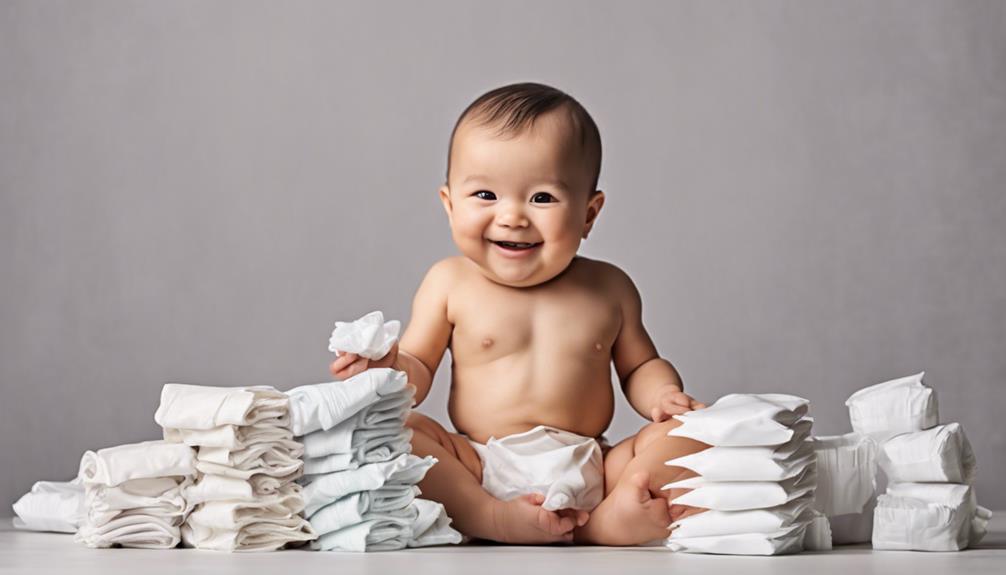When choosing between disposable diapers and cloth diapers, consider the following: Cloth diapers are cost-effective over time, reduce landfill waste, and can be better for the environment. Disposable diapers offer convenience for travel and daycare. Cloth diapers may help prevent diaper rash and could aid in potty training, but there’s limited scientific evidence to support this. Reusable cloth diapers may have better absorbency due to the materials used. To make an informed decision, weigh the pros and cons based on your baby’s needs, budget, and environmental concerns. Additional insights on diaper types and their impact are beneficial.
Key Takeaways
- Cloth diapers cost less over time and are eco-friendly.
- Disposable diapers offer convenience for travel and daycare.
- Cloth diapers may reduce diaper rash and irritation.
- Disposable diapers have superior absorbency and quick moisture absorption.
- Cloth diapers made from natural materials are safe and breathable.
Cloth diapers
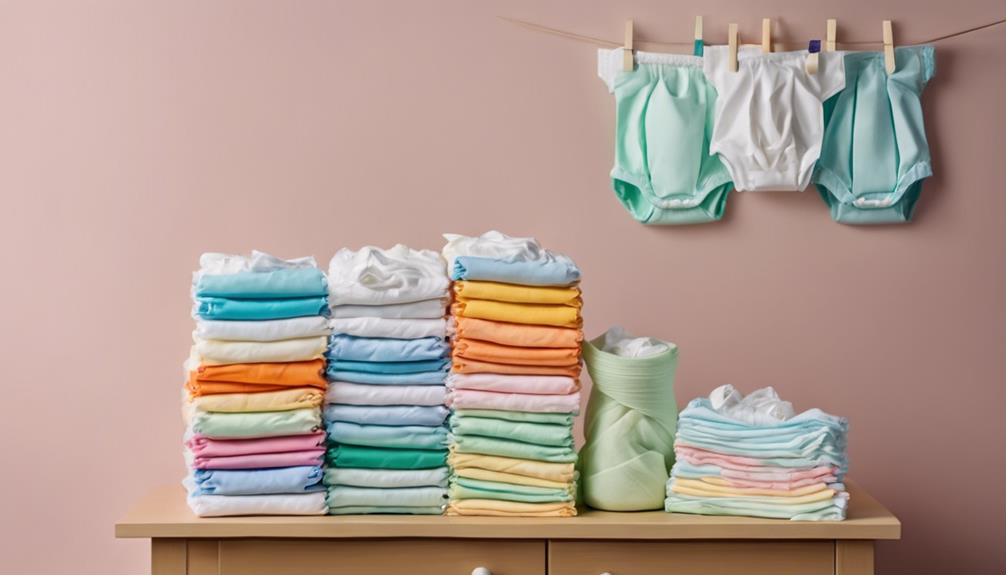
When considering cloth diapers, it’s essential to weigh the pros and cons carefully.
Cloth diapers offer cost savings in the long term and are environmentally friendly.
However, they require more effort in terms of maintenance and handling.
Pros
What advantages do cloth diapers offer over disposable diapers?
Cloth diapers come with several benefits:
- Lower total cost: Although the initial investment is higher, cloth diapers are more economical in the long run.
- Less irritation for some babies: Cloth diapers may lead to fewer diaper rashes due to increased vigilance in changing them regularly.
- Bridge to the potty: Cloth diapers can facilitate an easier transition to potty training for some children.
Cons
While cloth diapers offer economic advantages and potential benefits for certain babies, they come with several drawbacks that may dissuade parents from selecting this option:
- Lower Absorbency: Cloth diapers require more frequent changes due to their reduced absorbency, resulting in increased laundry and higher utility bills.
- Messier Cleaning Process: Cleaning cloth diapers can be more labor-intensive and messy, as they need to be washed after each use.
- Increased Risk of Diaper Rash: Cloth diapers may contribute to more diaper rash occurrences, especially if not changed promptly or if the baby has sensitive skin.
Here is a table illustrating the pros and cons of cloth diapers:
| Pros of Cloth Diapers | Cons of Cloth Diapers |
|---|---|
| Environmentally Friendly | Initial Investment Cost |
| Cost-effective in the Long Run | Increased Laundry Load |
| Less Chemical Exposure for Babies | Requires More Frequent Changes |
| Soft and Comfortable for Baby | Not as Convenient for Traveling or Daycare |
| Reduced Risk of Diaper Rash | May Require Additional Inserts or Boosters for Absorbency |
Disposable diapers
When considering disposable diapers, it is essential to weigh the pros and cons of this option. Disposable diapers offer convenience and ease of use, with the benefit of quick disposal, but the environmental impact and long-term costs should also be taken into account.
Understanding the advantages and drawbacks of disposable diapers is crucial in making an informed decision regarding your baby’s diapering needs.
Pros
Disposable diapers offer numerous advantages that make them a popular choice among parents for their convenience and ease of use. Some of the top benefits include:
- Convenience: Disposable diapers are easy to use and change, thanks to their fastening strips and size options for a better fit.
- Easier on the go: They simplify outings and travel since you can dispose of them without carrying soiled diapers back home.
- Fewer daily changes: Ultra-absorbent disposable diapers with inner liners reduce the frequency of changes, keeping wetness away and minimizing leaks.
These aspects of disposable diapers contribute to their widespread availability and efficiency for quick changes, making them a practical choice for busy parents.
Cons
While disposable diapers offer convenience and widespread use, they come with several drawbacks to consider:
- Potential Skin Irritation: Disposable diapers may contain chemicals, dyes, and gels that could irritate a baby’s skin, potentially leading to diaper rash for some infants.
- Financial Investment: Disposable diapers tend to be more expensive than cloth alternatives over the diaper-wearing years, posing a significant financial burden for parents.
- Durability Concerns: Disposable diapers are less durable than cloth diapers, with tabs that can easily rip, resulting in potential wastage and additional expenses.
- Potty Training Challenges: The ultra-absorbent nature of disposables may hinder potty training efforts, as children may be less motivated to transition out of diapers when they don’t feel wet or uncomfortable.
Here’s a table outlining the pros and cons of disposable diapers:
| Pros of Disposable Diapers | Cons of Disposable Diapers |
|---|---|
| Convenient and easy to use | Generate significant waste |
| Absorbent, reducing the risk of leaks and messes | Can be expensive over time |
| Widely available, found in most stores | May contain chemicals or fragrances that irritate sensitive skin |
| Time-saving for busy caregivers | Contribution to landfill waste and environmental concerns |
| Can be more convenient during travel or outings |
Related Articles:
Are cloth diapers or disposable diapers better for the environment?
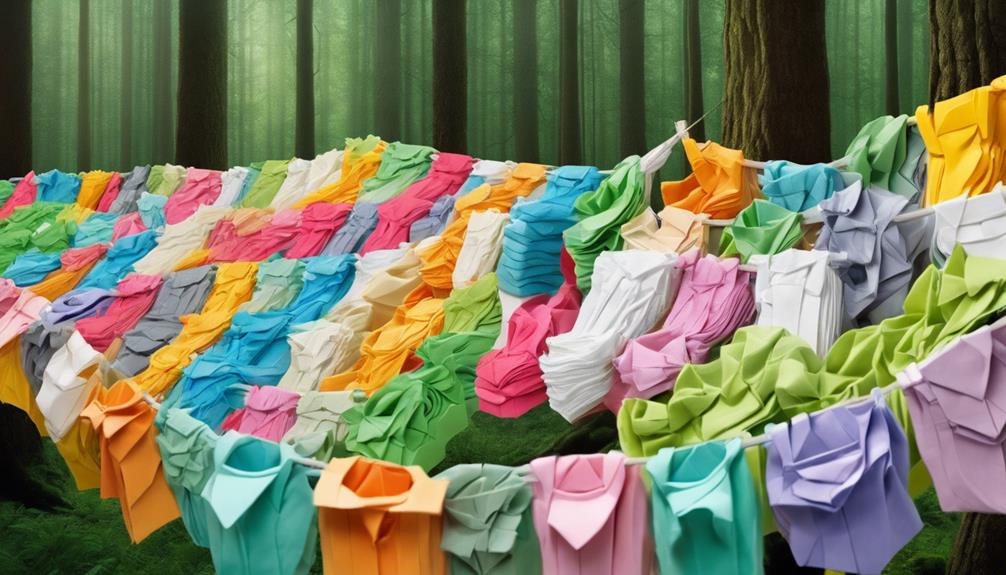
Both cloth diapers and disposable diapers have environmental impacts that must be carefully considered when deciding which option is better for the environment. Disposable diapers contribute significantly to landfill waste, with an estimated 3.5 million tons per year in the U.S. alone. On the other hand, cloth diapers, although made from resource-intensive cotton and requiring more water to produce, can be more environmentally friendly when laundered efficiently and used for multiple children.
The decision between cloth and disposable diapers can be complex, with factors such as energy consumption, water usage, and waste production all playing a role. Ultimately, making an informed choice based on individual circumstances and habits is crucial in minimizing the environmental impact of diaper use.
- Disposable diapers contribute to millions of tons of landfill waste annually.
- Cloth diapers, although resource-intensive, can be more environmentally friendly when used efficiently.
- Factors such as energy consumption and water usage should be considered when choosing between cloth and disposable diapers.
Are cloth diapers better for diaper rash?
Studies and expert opinions suggest that when it comes to preventing the most common type of diaper rash, cloth diapers may have certain advantages over disposable diapers. While disposable diapers excel in keeping babies dry due to their high absorbency and technology like superabsorbent polymers, cloth diaper advocates argue that cloth diapers may be better at preventing diaper rash caused by prolonged exposure to moisture.
Some parents believe that the frequent changing required with cloth diapers helps to reduce the likelihood of diaper rash compared to disposable diapers. However, it is essential to note that either type of diaper can still lead to rashes, with disposable diapers typically faring better in preventing irritant diaper dermatitis.
Ultimately, the choice between cloth and disposable diapers regarding diaper rash prevention may vary depending on the baby’s sensitivity and the caregiver’s diligence in changing diapers promptly.
Do cloth diapers help make potty training easier?
While some sources suggest that babies in cloth diapers may potty train earlier, scientific evidence supporting this claim is currently lacking. Dr. Bruce Taubman, a pediatrician, mentioned the absence of data linking cloth diapers to accelerated potty training. A 1987 study in Japan comparing cloth and disposable diaper users found no significant difference in potty training age. Additionally, an article comparing global diapering practices highlighted cultural influences on potty training age, indicating that the choice of diaper may not be a determining factor. Therefore, it’s essential for parents to consider various aspects beyond the type of diaper when aiming to facilitate potty training for their children.
Parents should focus on individual readiness cues rather than solely relying on the type of diaper used.
Factors like consistency, positive reinforcement, and establishing routines play crucial roles in successful potty training.
Consulting pediatricians or child development experts can provide personalized guidance on effective potty training strategies.
Recommended: Disposable Training Pants for Easy Potty Training
Are Cloth Diapers Safe?
Considering the environmental impact, cost-efficiency, and maintenance requirements, cloth diapers are generally regarded as a safe and viable option for parents looking to explore alternative diapering choices.
Cloth diapers are made from materials such as cotton, hemp, or bamboo, which are natural and gentle on a baby’s delicate skin. Unlike disposable diapers, cloth diapers do not contain chemicals like dioxins, phthalates, or fragrances that may cause irritation or allergic reactions.
The breathability of cloth diapers also helps in reducing the risk of diaper rash by allowing more air circulation. Additionally, cloth diapers are reusable, reducing the exposure of babies to potentially harmful substances found in disposable diapers.
Proper washing and care of cloth diapers are essential to maintain their safety and effectiveness. By following recommended washing instructions, using gentle detergents, and ensuring thorough rinsing, cloth diapers can be a safe and eco-friendly choice for families concerned about their baby’s well-being.
Are disposable diapers comfortable?

Disposable diapers have long been a popular choice for parents due to their convenience and ease of use, but the question remains: are disposable diapers comfortable for babies? Many parents believe that disposable diapers offer a high level of comfort for their little ones due to their soft materials and snug fit. However, there are a few factors to consider when evaluating the comfort of disposable diapers:
- Absorbency: Disposable diapers are designed to quickly absorb moisture, keeping babies dry and comfortable.
- Breathability: Some disposable diapers come with breathable materials to prevent rashes and keep the baby’s skin healthy.
- Flexibility: The stretchy sides and adjustable tabs of disposable diapers allow for a comfortable and secure fit, catering to the baby’s movements.
Is Cloth Diapering easier than disposable?
Opting for cloth diapering presents a slightly more labor-intensive routine compared to utilizing disposable diapers. With cloth diapers, expect to wash an additional load of laundry every two days when caring for one baby in diapers.
The process of rinsing poopy diapers may seem messy at times, but it is comparable to dealing with a soiled disposable diaper. However, cloth diapers have the advantage of reducing the occurrence of ‘blowouts’ during the early stages, providing a more secure fit.
While cloth diapering requires more effort in terms of maintenance, it offers cost savings in the long run and is known for being comfortable and visually appealing. The comfort, cost-effectiveness, and reduced likelihood of leaks make cloth diapering an attractive option for many parents, despite the slightly increased level of involvement needed in the diaper-changing process.
Are cloth diapers cheaper?
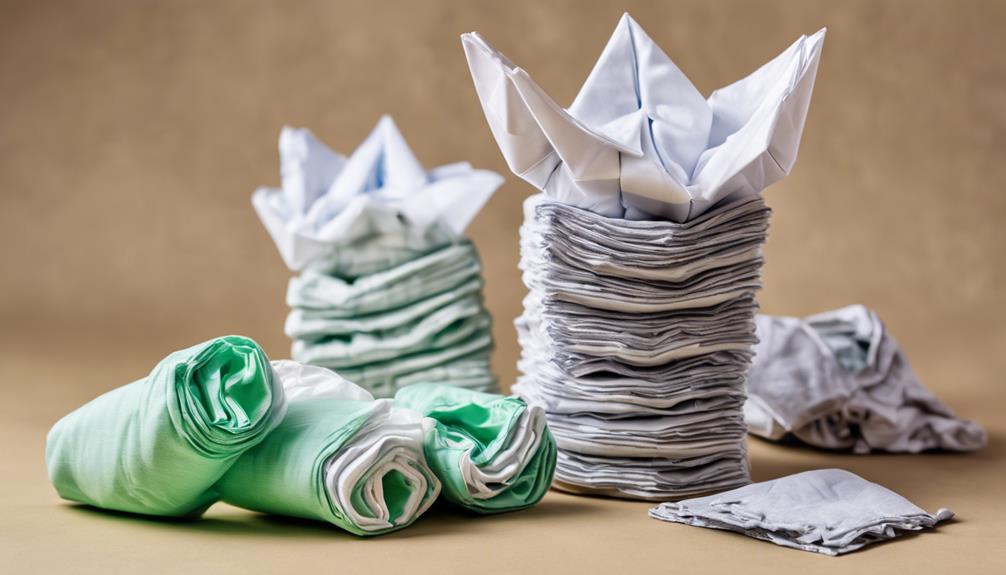
When evaluating the financial aspect of diapering, the cost-effectiveness of cloth diapers becomes a key consideration for many parents seeking to manage expenses associated with caring for a new baby.
Cloth diapers, such as the BumGenius 5.0 pocket diapers, can cost about $300 for a set of 18 diapers and 36 inserts.
Energy costs for washing cloth diapers two to three times per week can amount to around $60 to $110 per year, depending on the type of washing machine used.
Over three years, using cloth diapers may save you approximately $120 to $270 compared to using disposable diapers.
In considering the long-term financial impact, the initial investment in cloth diapers may prove to be a more economical choice for some families. However, factors such as utility costs, laundry frequency, and personal preferences can influence the overall cost-effectiveness of cloth diapering.
Recommended: The Ultimate Guide to Finding the Cheapest Disposable Nappies
Do Cloth Reusable Diapers have better absorbency than disposable ones?
In the realm of diaper performance, absorbency stands as a critical factor differentiating cloth reusable diapers from their disposable counterparts. Cloth reusable diapers are often praised for their superior absorbency compared to disposable diapers. This is due to the materials used in cloth diapers, such as hemp or bamboo inserts, which are known for their high absorbency levels. These materials have natural fibers that can hold more liquid, making them a popular choice for parents looking for long-lasting dryness and leak protection.
On the other hand, disposable diapers have come a long way in terms of absorbency technology. Most disposable diapers now feature super absorbent polymers that can hold a significant amount of liquid, keeping babies dry for extended periods. However, some parents still find that cloth diapers offer better absorbency, especially overnight or for heavy wetters, as they can be customized with additional inserts for extra absorbency.
Ultimately, the absorbency of cloth reusable diapers versus disposable diapers may vary based on the specific brand, style, and materials used, as well as the individual needs of the baby.
Disposable diapers vs cloth diapers comparison chart

Comparing disposable diapers to cloth diapers can provide valuable insights for parents seeking to make an informed decision about which option best suits their needs and preferences. To aid in this comparison, let’s consider some key factors:
- Cost-effectiveness: Cloth diapers may require a higher initial investment but can save money in the long run as they are reusable, while disposable diapers incur ongoing costs.
- Environmental impact: Cloth diapers are more eco-friendly as they reduce waste sent to landfills compared to disposable diapers, which contribute significantly to environmental pollution.
- Convenience: Disposable diapers are generally more convenient for travel or daycare, while cloth diapers require more frequent changes and washing but can be convenient if laundry routines are well-established.
Below is a comprehensive comparison chart outlining the differences between disposable diapers and cloth diapers:
| Cloth Diapers | Disposable Diapers | |
|---|---|---|
| Cost | $300-$600 per child over 2 years, generally more cost-effective over time | May have a small learning curve, and requires washing, additional effort, and time |
| Convenience | Natural fibers, have less risk of irritation, only fabrics touch a baby’s skin | Super convenient, little learning curve, disposable, no washing required |
| Environmental Impact | Reduce landfill waste, potential increase in water/energy use | Increase landfill waste, raw material production |
| Diaper Rash and Skin Health | May contain chemicals or fragrances, disposable materials touch the baby’s skin | Leg and waist elastics contain messes, and prevent leaks, but may require more frequent changes, leakage possible |
| Comfort and Fit | One-size options available, soft fabrics, breathable, customizable fit, adjustable to grow with baby | Soft materials, various sizes, snug fit, need to purchase multiple sizes |
| Absorbency and Leakage | May use training pants, a similar transition process | Rely on absorbent core, quick absorption, some have stretchy cuffs, reduced leakage risk |
| Potty Training | Transition to training pants easier | May have a small learning curve, and requires washing, additional effort and time |
| Availability | Widely available in stores | Limited availability, more common online |
This comparison chart provides a comprehensive overview of the key differences between disposable diapers and cloth diapers, helping you make informed decisions based on their preferences and priorities.
Cloth or disposable diapers: What should you choose?
Deciding between cloth or disposable diapers hinges on finding the best fit for your family’s lifestyle and values. Cloth diapers are reusable, environmentally friendly, and cost-effective over time. They come in a variety of styles, such as pre-folds, flats, fitted, and all-in-ones, catering to different preferences. Cloth diapers require more effort in terms of washing and maintenance but can be gentler on a baby’s skin due to their breathable materials.
On the other hand, disposable diapers offer convenience, especially for busy families or when traveling. They are highly absorbent, reducing the frequency of changes and potential leaks. While disposable diapers generate more waste and contribute to environmental concerns, they can be a practical choice for some families.
Ultimately, the decision between cloth and disposable diapers depends on your priorities and circumstances. Consider factors like budget, convenience, environmental impact, and baby’s comfort when making this choice, knowing that you can always adjust your approach as needed.
Reusable swim diapers vs disposable diapers
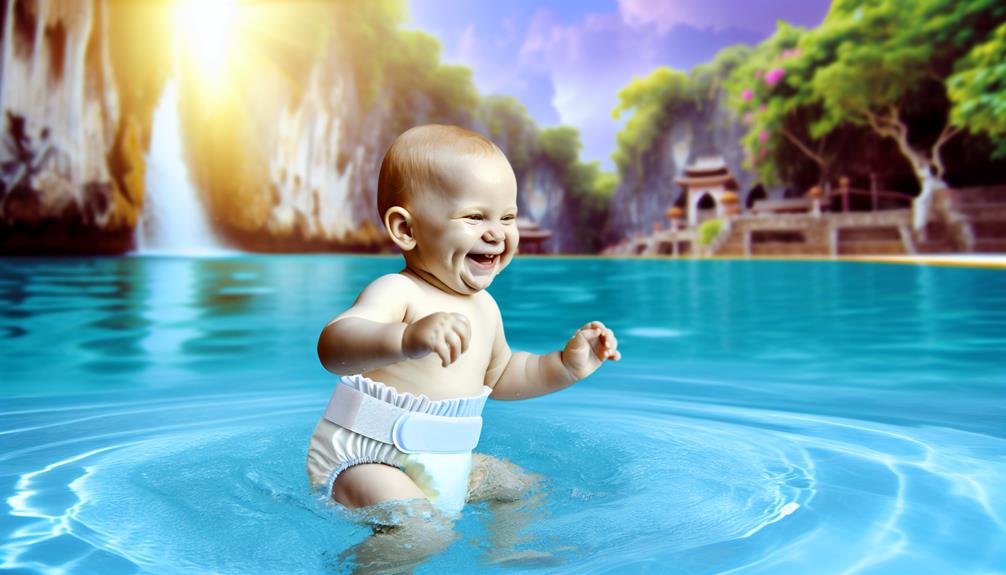
When considering diaper options, another important choice to weigh is between reusable swim diapers and disposable swim diapers. Reusable swim diapers offer several advantages over their disposable counterparts:
- Less wasteful: One reusable swim diaper can last a full swim season or even longer, making them a more environmentally friendly choice.
- Snug fit: Reusable swim diapers provide a secure fit, reducing the chances of any accidents in the pool and giving parents peace of mind.
- Cost-efficient: While the upfront cost of reusable swim diapers may be higher, they can save families money in the long run. Instead of purchasing multiple packs of disposable swim diapers, investing in one or two reusable swim diapers can cover the entire swim season.
Considering these factors, reusable swim diapers emerge as a practical and sustainable option for families looking to enjoy the pool while minimizing waste and costs.
Blog Series:
- Cost of Disposable Diapers vs Cloth Diapers Options
- Biodegradable Disposable Diapers
- Diaper Manufacturers Worldwide
- Diaper Manufacturing Companies
Conclusion
In conclusion, the choice between cloth and disposable diapers ultimately depends on individual preferences and priorities.
While cloth diapers are more environmentally friendly and may reduce the risk of diaper rash, disposable diapers offer convenience and ease of use.
Both options have their own set of pros and cons, much like choosing between two paths in a forest – one may be more scenic but challenging, while the other is quicker and more straightforward.

